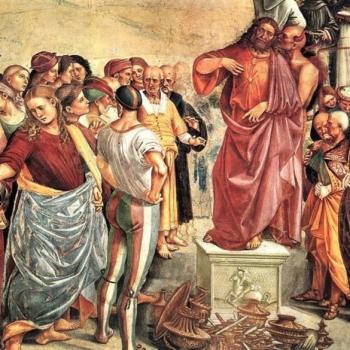Susan Holman (The Hungry Are Dying) draws on recent scholarship to argue that “food doles, communal religious feasts, public works, or subsidized public entertainment prior to the Christianization of Graeco-Roman culture did not function out of any concern to alleviate poverty per se.” These “public works” or leitourgia sometimes “funded the education of those boys eligible for such training, either by their noble birth or their ability to finance the public obligations that would be expected of them as trained ephebes.” Others “funded performances and feasts” with the goal of asserting “social power and do one’s honorable duty. The donor fulfilled civic obligations while the recipients, by participating, were implicitly expected to show their gratitude by granting the benefactor praise, honor, and loyalty.” Leitourgia assumed and reinforced social hierarchies: “Aristotle operates on this premise in his distinction between leitourgia and friendship, when he says that friendship expects an equal exchange of goods or value between the parties. If the recipients could not give as much as they received, then the act was a leitourgia, a ‘public service.’ In Latin the various acts of euergetism involved in a leitourgia were called beneficences” (32).
In Christian texts, the term retains this meaning, but another layer is added. In the LXX and early Christian writing, leitourgia “usually refers to formal worship ritual, in the Greek-speaking public sphere it continued for centuries to bear the other connotations of civic duties, always simultaneously understood to refer to acts of piety to the gods. In the early fourth century, Eusebius of Caesarea includes among the Diocletian martyrs the bishop Phileas of Thmuis, ‘a man esteemed for his patriotic activities and public services [leitourgia], and for his work as a philosopher.’ Eusebius uses leitourgia in the same sense in describing the martyred Vettius Epagathus, a man of high social status in Gaul, who was ‘untiring in leitourgia to his neighbor, utterly devoted to God, and fervent in spirit’”(49).
Yet the term doesn’t lose its older connotation of “public works” on behalf of the needy, and the two uses are connected. The “link between religious liturgy and the social leitourgia that cares for the poor body is part of the Christian liturgy from the very earliest texts, even New Testament texts where the ‘liturgy’ of Jesus’s disciples actually occurs in the Temple precincts (e.g., Acts 3:1-5). According to Justin Martyr, a collection for the poor was taken as part of the weekly worship service and the funds enabled the leader of the congregation to care for orphans, widows, the sick, the prisoners, strangers, and ‘all those in need.’ The Didache also advocated a regular collection of food as part of worship and, ‘if you have no prophet give them to the poor’” (50).
Besides these links between worship and charity, “the Christian ideal of voluntary poverty was usually associated with a piety that took special care of the involuntary poor. For example, 1 Clement suggested that ‘many have sold themselves to slavery and, receiving the price paid for themselves, have fed others.’ Early bishops, too, were expected to live poorly and to provide for the poor around them.” Indeed, “the person who did not will to be poor was often assumed to be implicitly inferior, a victim of the passions and desires that engender need and create the dependence that precludes true self-mastery. Clement of Alexandria admits this when he says, ‘For not riches only, but also honour and marriage and poverty have ten thousand cares for him who is unfit for them’” (50).















